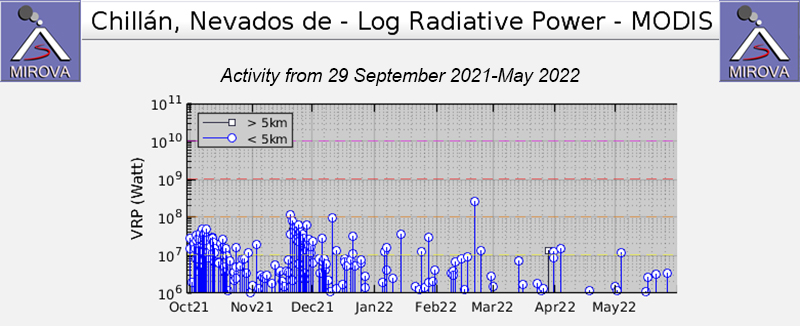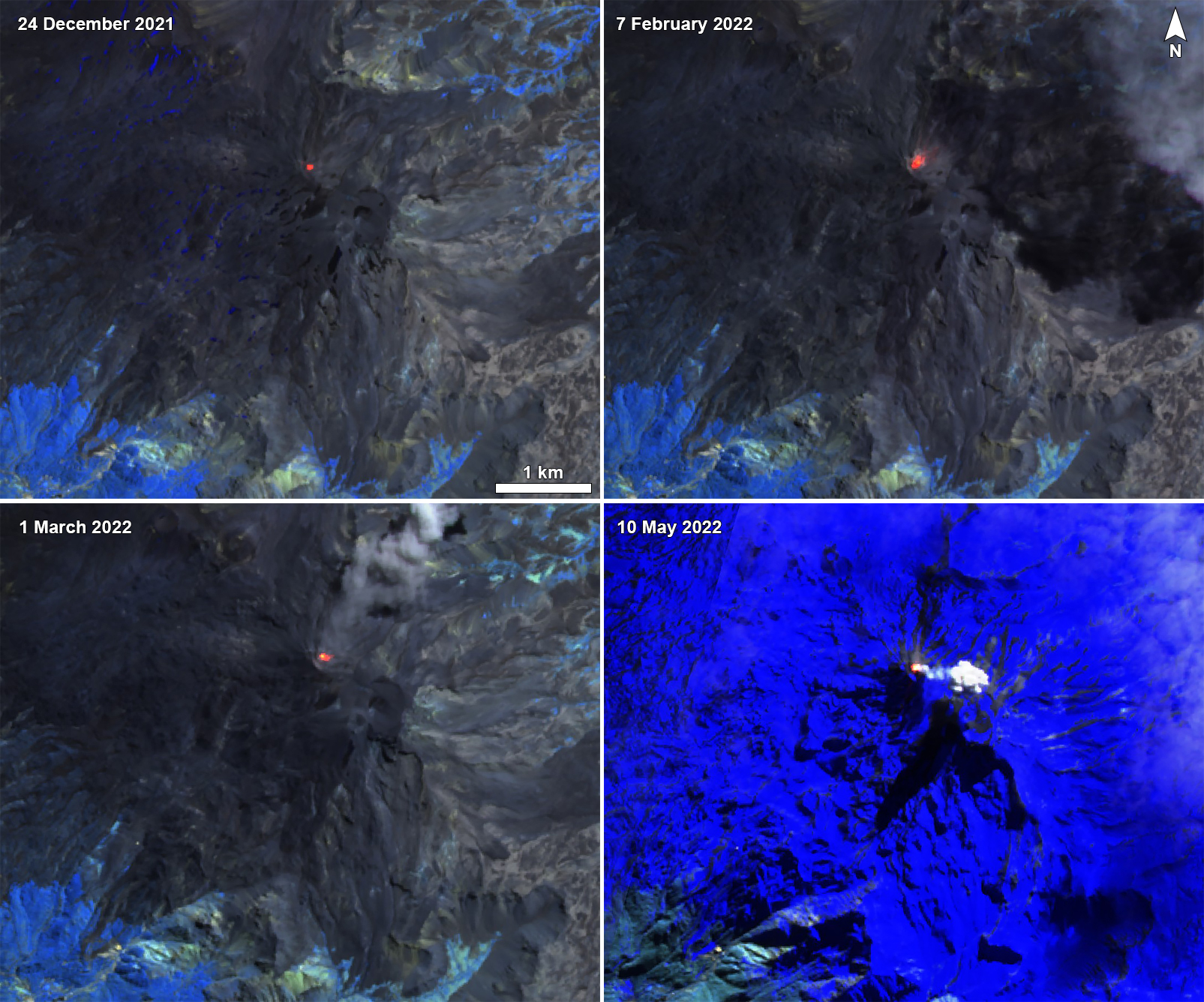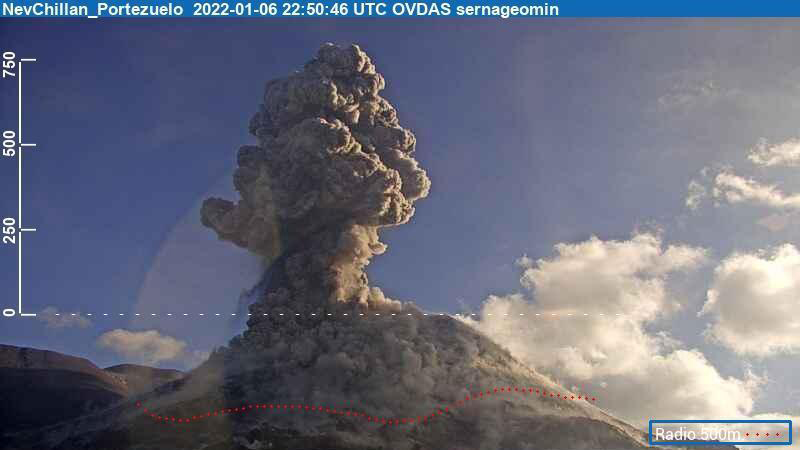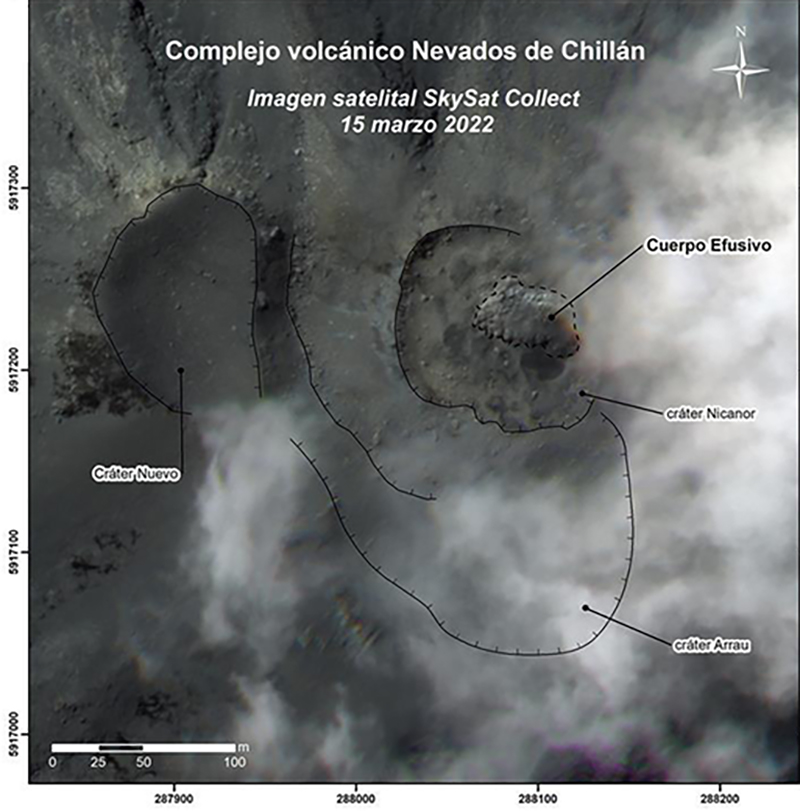Report on Nevados de Chillan (Chile) — June 2022
Bulletin of the Global Volcanism Network, vol. 47, no. 6 (June 2022)
Managing Editor: Edward Venzke.
Edited by Kadie L. Bennis.
Nevados de Chillan (Chile) Pyroclastic flows, gas-and-ash plumes, and a new lava dome during December 2021-May 2022
Please cite this report as:
Global Volcanism Program, 2022. Report on Nevados de Chillan (Chile) (Bennis, K.L., and Venzke, E., eds.). Bulletin of the Global Volcanism Network, 47:6. Smithsonian Institution. https://doi.org/10.5479/si.GVP.BGVN202206-357070
Nevados de Chillan
Chile
36.868°S, 71.378°W; summit elev. 3180 m
All times are local (unless otherwise noted)
Nevados de Chillán, located in the Chilean Central Andes, has had multiple recorded eruptions dating back to the seventeenth century. The most recent eruption began in January 2016 with a phreatic explosion and ash emission from the new Nicanor crater on the E flank of Nuevo crater. More recently, lava flows and domes, along with multiple daily reports of ash emissions and block-and-ash flows, have been reported (BGVN 46:12). Two new lava domes were described in September and October 2021, followed by a surge of lava flow activity in November. This report covers activity from December 2021 through May 2022 and describes seismic and thermal activity, gas-and-ash plumes, and pyroclastic flows. Information comes primarily from Chile's Servicio Nacional de Geología y Minería (SERNAGEOMIN)-Observatorio Volcanológico de Los Andes del Sur (OVDAS), the Buenos Aires Volcanic Ash Advisory Center (VAAC), and satellite data.
According to an analysis of digital elevation models, about 1.5 million cubic meters of effusive material was emitted during 17 September-2 December 2021. During December 2021-May 2022 there was continuing eruptive activity in the Nicanor crater, which consisted dominantly of seismic events, sulfur dioxide emissions, and thermal anomalies (table 2). By 13 December the L7 and L8 flows were no longer advancing, based on Sentinel-2 L2A imagery. Gas-and-ash plumes rose generally 1-2.2 km above the crater, generated by the several hundreds of explosions detected each month. Intermittent pyroclastic flows accompanied these eruptive events, traveling as far as 580 m down multiple flanks. Incandescent ejecta rose several hundred meter above the crater rim during many of the explosions, with some material falling back on the proximal flanks. A new dome (Dome 4) was first detected in early March.
Table 2. Summary of seismic events, maximum sulfur dioxide values, and number of thermal anomalies at Nevados de Chillán during December 2021-May 2022. Data from SERNAGEOMIN bi-weekly reports.
| Month | Number of volcano-tectonic (VT) events | Number of hybrid-type (HB) events | Number of long-period (LP) events | Number of explosion-related (EX) events | Number of tremor (TR) events | Daily maximum sulfur dioxide value | Number of days a thermal anomaly was detected in Sentinel-2 L2A images |
| Dec 2021 | 99 | -- | 1,957 | 832 | 388 | 437 t/d | 8 |
| Jan 2022 | 1,240 | 2 | 1,652 | 707 | 488 | 880 t/d | 8 |
| Feb 2022 | 127 | -- | 1,343 | 456 | 301 | 307 t/d | 8 |
| Mar 2022 | 80 | -- | 1,857 | 658 | 631 | 2,300 t/d | 10 |
| Apr 2022 | 76 | -- | 1,477 | 418 | 532 | 1,071 t/d | 9 |
| May 2022 | 92 | -- | 1,662 | 451 | 659 | 802 t/d | 10 |
During mid-November 2021 there were multiple surges along the L7 and L8 flows; lava from the L7 flow reached 477 m to the N and 465 m down the L7b channel to the NE and 198 m in the L8 channel (BGVN 46:12). Thermal activity gradually decreased in energy from mid-November through early December 2021, due to the cessation of the L7 and L8 lava flows (figure 95). After December, the thermal anomalies became intermittent and relatively low in power compared to November. Four anomalies were detected by the MODVOLC thermal system during this time, on 1 December 2021, 14 January, and 28 January 2022. Sentinel-2 infrared satellite imagery showed a persistent thermal anomaly in the active Nicanor crater, sometimes accompanied by a gas-and-ash plume that drifted NE and E (figure 96).
Activity during December 2021 consisted of frequent seismic events and daily explosive events that originated from the Nicanor crater. Surveillance cameras showed that explosions often ejected gas-and-ash plumes 300 m high; the highest was 1.6 km on 4 December. Strong nighttime incandescence was visible on 7 and 11 December, accompanied by material that was ejected less than 600 m away. Based on high-resolution SkySat satellite images, the L7 lava flow advanced 560 m with a speed of 0.5 m/hour along the central lobe and 596 m with a speed of 1.6 m/hour along the secondary lobe. According to analysis of Sentinel-2 L2A images, the L7 and L8 flows no longer advanced after 13 December. On 24-25 December a gas-and-ash plume rose 1.8 km above the crater. Some new effusive material was reported in the Nicanor crater, based on thermal camera images and Sentinel-2 L2A images during 16-31 December. The average sulfur dioxide values, recorded by Differential Absorption Optical Spectroscopy (DOAS) equipment, were 236 ± 51 t/d during 1-15 December and 196 ± 42 t/d during 16-31 December.
Seismicity increased in January 2022 and intermittent incandescence was observed throughout the month. Around 1944 on 6 January an explosion generated a pyroclastic flow which traveled less than 400 m NE from the crater rim, according to SERNAGEOMIN. A gas-and-ash plume from the event rose 2.2 km above the crater (figure 97), accompanied by nighttime incandescence visible less than 250 m high. A small cone was growing in the active crater due to the constant accumulation of pyroclasts. A gas-and-ash plume rose 1.6 km high on 19 January. Explosions generated pyroclastic flows on 19, 25, and 26 January that traveled less than 500 m down the NE, N, and NW flanks. During 25-26 January incandescent material was ejected 500 m toward the N flank. The average sulfur dioxide value was 269 ± 67 t/d during 1-15 January and 285 ± 60 t/d during 16-31 January.
Similar explosive activity and seismicity persisted in February with intermittent nighttime incandescence. Pyroclastic flows due to continued explosions were detected on 5, 7, 9, 12, 13, and 19-20 February which descended the NE and E flanks as far as 580 from the crater rim. An explosion on 13 February generated a gas-and-ash plume that rose 1.9 km above the crater and produced a pyroclastic flow. Gas-and-ash plumes rose 1.6 km high on 16 February, 1.2 km high on 19 February, and 1.7 km high on 20 February. Material was ejected less than 500 m from the crater, accompanied by gas-and-steam emissions during 25-28 February. The event on 20 February also ejected incandescent material radially less than 500 m from the crater onto the N and W flanks. The average sulfur dioxide value was 137 ± 29 t/d during 1-15 February and 221 ± 70 t/d during 16-28 February.
On 1 March new effusive material was observed in the Nicanor crater using Planet satellite images, which was also reflected as a thermal anomaly in Sentinel-2 L2A images. Explosions continued, generating gas-and-ash plumes as high as 1.6 km above the crater. Plumes on 10, 11, 13, and 15 March rose 1 km, 1.2 km, 1 km, and 1.6 km high, respectively. Some explosions generated pyroclastic flows down the SE and E flanks as far as 460 m from the crater rim. Intermittent incandescence of varying power persisted in the active crater. On 13 March incandescence rose as high as 230 m. According to a SkySat satellite image from 15 March the effusive mass in the active crater (now called “Dome 4”) was 57 m long, 33 m wide, growing to the NE and SE, and covered an area of 1.7 m2 (figure 98). On 25 March a pyroclastic flow descended the NW flank of the active crater as far as 500 m. Incandescent material was ejected 500 m to the NE and N on 23, 25, and 31 March. The average sulfur dioxide value was 454 ± 24 t/d during 1-15 March and 537 ± 140 t/d during 16-31 March. The increase in sulfur dioxide rates was due to a new effusion in the Nicanor crater, according to SERNAGEOMIN.
The new lava effusion was still visible in the Nicanor crater during April. Gas-and-ash plumes rose as high as 1.6 km on 15 April. As a result, a pyroclastic flow descended 500 m down the N and NE slope. Crater incandescence remained at low to moderate levels. The average sulfur dioxide value was 595 ± 80 t/d during 1-15 April and 551 ± 68 t/d during 16-30 April.
Explosions persisted during May, producing gas-and-ash plumes as high as 900 m on 16 May, which generated pyroclastic flows down the SE, NE, and W flanks as far as 400 m from the crater rim. Low to moderate incandescence was also visible up to 200 m high. Based on a SkySat image, numerous fissures and emission centers were noted in a E-W trend in the S and SW part of the growing lava dome, characterized by passive degassing. On 20 and 21 May gas-and-ash plumes rose 920 m high and generated proximal pyroclastic flows down the E flank as far as 400 m from the crater rim; material was ejected 350 m down the W slope, which included ashfall deposits. Incandescence was visible up to 200 m high on 31 May. The average sulfur dioxide value decreased compared to the previous month to 466 ± 54 t/d during 1-15 May and 363 ± 58 t/d during 16-31 May.
Geological Summary. The compound volcano of Nevados de Chillán is one of the most active of the Central Andes. Three late-Pleistocene to Holocene stratovolcanoes were constructed along a NNW-SSE line within three nested Pleistocene calderas, which produced ignimbrite sheets extending more than 100 km into the Central Depression of Chile. The dominantly andesitic Cerro Blanco (Volcán Nevado) stratovolcano is located at the NW end of the massif. Volcán Viejo (Volcán Chillán), which was the main active vent during the 17th-19th centuries, occupies the SE end. The Volcán Nuevo lava-dome complex formed during 1906-1945 on the NW flank of Viejo. The Volcán Arrau dome complex was then constructed on the SE side of Volcán Nuevo between 1973 and 1986, and eventually exceeded its height. Smaller domes or cones are present in the 5-km valley between the two major edifices.
Information Contacts: Servicio Nacional de Geología y Minería (SERNAGEOMIN), Observatorio Volcanológico de Los Andes del Sur (OVDAS), Avda Sta María No. 0104, Santiago, Chile (URL: http://www.sernageomin.cl/, https://twitter.com/Sernageomin); MIROVA (Middle InfraRed Observation of Volcanic Activity), a collaborative project between the Universities of Turin and Florence (Italy) supported by the Centre for Volcanic Risk of the Italian Civil Protection Department (URL: http://www.mirovaweb.it/); Hawai'i Institute of Geophysics and Planetology (HIGP) - MODVOLC Thermal Alerts System, School of Ocean and Earth Science and Technology (SOEST), Univ. of Hawai'i, 2525 Correa Road, Honolulu, HI 96822, USA (URL: http://modis.higp.hawaii.edu/); Sentinel Hub Playground (URL: https://www.sentinel-hub.com/explore/sentinel-playground).





